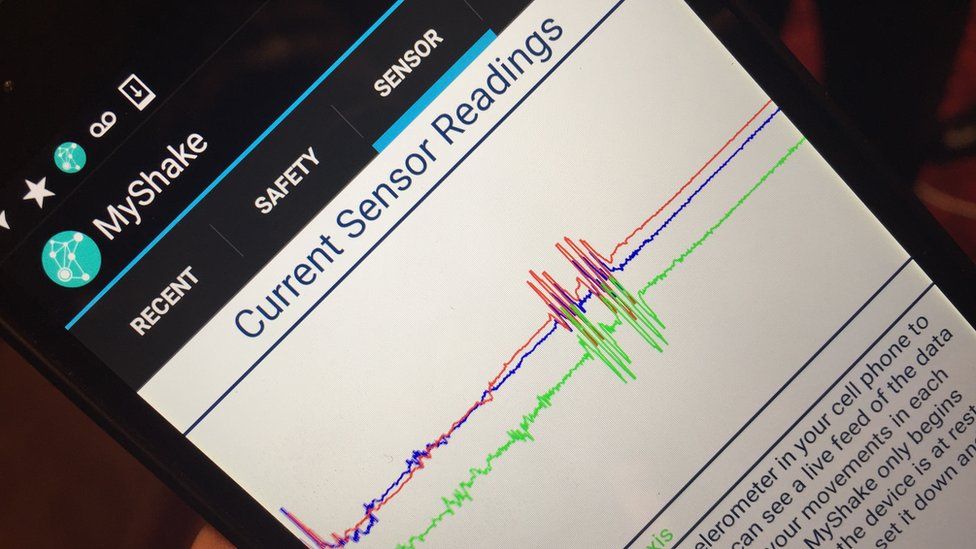How effective are earthquake early warning systems?
- Published

Earthquake early warning detection is more effective for minor quakes than major ones.
This is according to a new study from the United States Geological Survey.
Seismologists modelled ground shaking along California's San Andreas Fault, where an earthquake of magnitude 6.5 or more is expected within 30 years.
They found that warning time could be increased for residents if they were willing to tolerate a number of "false alarms" for smaller events.
This would mean issuing alerts early in an earthquake's lifespan, before its full magnitude is determined. Those living far from the epicentre would occasionally receive warnings for ground shaking they could not feel.
"We can get [greater] warning times for weak ground motion levels, but we can't get long warning times for strong shaking," Sarah Minson, lead author of the study, told BBC News.
"Alternatively, we could warn you every time there was an earthquake that might produce weak ground shaking at your location... A lot of baby earthquakes don't grow up to become big earthquakes," she added.
Earthquake early warning systems have been in place in Mexico and Japan for years. Now, a system called ShakeAlert is being developed for the west coast of North America.
So how can it predict the unpredictable? In short, it can't.
"It's a misnomer... because it's not earthquake early warning, the earthquake has already happened... It's ground motion early warning," said Dr Minson.
Earthquakes occur along tectonic plate boundaries and faults in the Earth's crust - long fractures where friction has built up over time.
Dr Lucy Jones, a seismologist who was not involved in the study, explained: "The whole fault doesn't move at once. It starts at an epicentre and the rupture moves down the fault like how you would rip a piece of paper."
This release of energy moves in two parts.
Primary waves (p-waves) accordion out first and fastest.
They are followed by slower secondary, or s-waves, which cause the ground to ripple up and down - the shaking that people experience during a quake.
Life on the line
The physics of earthquakes is one of the reasons why a single, universal warning system hasn't been rolled out across all quake prone countries.
California and Japan have populations living directly alongside fault lines, and cannot waste precious seconds before warning their citizens.
In both countries, the p-waves and some very rapid algorithms determine the potential magnitude and dispatch an alert.
But in Mexico, the capital city is about 300km from the nearest tectonic plate boundary.
This allows geologists to use a system that can take some more time to issue a warning. They wait to detect the s-waves.
Sirens blare in the streets of Mexico City whenever ground shaking above M5 is detected.
Better living through algorithms
However, the country's usually robust SASMEX early warning system didn't have sufficient time to respond to last September's second earthquake.
The system can usually provide up to a minute's warning but the M7.1 earthquake originated much nearer the city than usual. The ground began to shake almost immediately after the alarm was triggered.
A new algorithm was being tested for the SASMEX system at the time, which could, in the future, issue a warning 8-10 seconds earlier.
Similarly, Japanese seismologists have looked to improve their early warning system after the devastating 2011 M9 earthquake.
Dr Mitsuyuki Hoshiba, who has developed the new PLUM algorithm launched this week, explained. "In PLUM method: strength of shaking is predicted directly from observed shaking, skipping the process of estimation of epicentre and magnitude."
This will, Dr Hoshiba says, reduce the problem of missed alarms for future earthquakes.
The big one
Back in California, work continues on ShakeAlert.
It is due to have a limited public rollout later this year, supported by federal funding which was approved on Friday 23 March.
The system will use both ground-based seismometers and satellite observations to provide the maximum warning time to populations on the west coast.
The work done by Dr Minson and her colleagues shows that for San Francisco this may be about 50 seconds for minor shaking, or as little as eight seconds for a major earthquake.
If the system is to be as sensitive as possible, false alerts may also become a necessary part of life for Californians in the future.
Dr Cochran, who spent time in Mexico following the 2017 earthquakes, noted that "people wanted as much information as they could get, and they were not particularly bothered as long as they heard there was an earthquake associated with that alert."
Dr Jones agrees: "I do not believe that is a great shortcoming of early warning systems as long as it is understood... we need to invest in appropriate education for the general public about early warning for the information to be most effectively used."